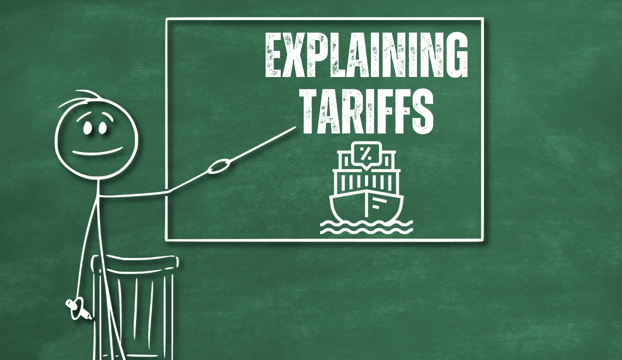The Truth About Tariffs: What They Are and How They Affect You
Take a deeper dive into tariffs—what they are, how they work, and their impact on consumers, businesses and international trade.
3/17/20253 min read


If you’ve ever heard the term "tariff" tossed around in political debates, trade wars, or economic news, you might wonder—what exactly is a tariff, and why does it matter? Whether you’re a consumer, a business owner, or just someone trying to understand the economy, tariffs can have a direct impact on your wallet and the prices of everyday goods.
What Is a Tariff?
A tariff is a tax or duty imposed by a government on imported goods. It’s essentially a fee that foreign products must pay to enter a country. Tariffs serve multiple purposes, such as:
Protecting Domestic Industries: By making foreign goods more expensive, tariffs encourage consumers to buy locally produced alternatives.
Generating Government Revenue: Before income taxes became the norm, tariffs were one of the main ways governments raised money.
Influencing Trade Relations: Countries use tariffs as economic tools, sometimes as leverage in trade negotiations or even in disputes.
Types of Tariffs
Not all tariffs work the same way. Here are the main types:
Ad Valorem Tariffs: Charged as a percentage of the good’s value (e.g., a 10% tariff on imported cars).
Specific Tariffs: Charged as a fixed amount per unit (e.g., $1,000 per imported vehicle).
Compound Tariffs: A combination of both ad valorem and specific tariffs.
How Do Tariffs Affect You?
While tariffs might seem like something that only concerns businesses and governments, they actually impact consumers in multiple ways:
1. Higher Prices on Imported Goods
When foreign products are taxed, businesses often pass those costs on to consumers. That means you might pay more for imported electronics, clothing, or even food.
2. Higher Prices on Domestic Goods Too
Even if you buy American-made products, tariffs can still raise costs. Many U.S. manufacturers rely on imported materials (like steel, aluminum, or microchips). If those materials face tariffs, the final product gets more expensive too.
3. Job Creation vs. Job Loss
Tariffs can help protect certain industries by making local goods more competitive. For example, if the U.S. places tariffs on foreign steel, American steel companies might see a boost in demand. However, industries that rely on cheap imports (like car manufacturing) might struggle, leading to job losses in other sectors.
4. Retaliation from Other Countries
When one country imposes tariffs, others often respond with their own. This can hurt American companies that export goods, as foreign markets become less accessible due to retaliatory tariffs.
5. Trade Wars and Economic Uncertainty
A full-blown trade war can disrupt global supply chains, cause market volatility, and create uncertainty for businesses and consumers alike. Prices fluctuate, investments stall, and economic growth slows down.
Historical Examples of Tariffs in Action
The Smoot-Hawley Tariff Act (1930): One of the most infamous tariffs in U.S. history, this law raised import taxes on thousands of goods, worsening the Great Depression as global trade collapsed.
Trump’s China Tariffs (2018-2020): A major trade conflict erupted when the U.S. imposed tariffs on billions of dollars' worth of Chinese goods, prompting China to retaliate with tariffs on American products like soybeans and cars.
Biden’s Tariff Policies: While keeping some tariffs in place, the Biden administration focused more on strategic trade policies and alliances to counter economic competition.
Current Events
The Trump administration has recently imposed new tariffs on goods from Canada, Mexico, and China, citing concerns over trade imbalances, fentanyl trafficking, and undocumented immigration. The tariffs include a 25% duty on imports from Canada and Mexico, except for Canadian energy products, which face a 10% tariff. These measures, implemented under the International Emergency Economic Powers Act, mark a significant policy shift as no prior president has used this law for trade sanctions.
Economists warn that these tariffs could slow U.S. economic growth, increase inflation, and disrupt North American trade. Proponents argue that the tariffs will strengthen U.S. trade policy and pressure neighboring countries to address U.S. concerns, while critics believe they will raise prices for American consumers and strain relationships with key trading partners. The agricultural and auto industries are expected to be particularly affected, with concerns about potential retaliation from Canada and Mexico.
Are Tariffs Good or Bad?
There’s no simple answer—tariffs can be both beneficial and harmful, depending on the situation. They can protect domestic industries and jobs but also raise costs for businesses and consumers. While they can be used as a tool for economic leverage, they can also lead to trade wars and economic uncertainty.
Final Thoughts
Understanding tariffs is essential because they shape the prices we pay and the overall economy. Whether you’re buying a smartphone, a car, or groceries, tariffs may be influencing the final cost. As global trade evolves, so will the role of tariffs, making it crucial to stay informed.
For more government breakdowns like this, follow Briefing Room 101—because Knowledge is Power!
